Unveiling the Microstructure Evolution and Mechanical Strengthening Mechanisms in Mg–2Y–xZn Alloys
Highlights
- Zn content controls X/W/I phase formation in Mg–2Y–xZn, with solidification clarified by simulation.
- Mg–2Y–xZn alloys show unique orientation relationships between intermetallic compounds.
- X/W phases synergistically strengthen Mg–2Y–xZn, while W/I phases compete in fracture.
Abstract
1. Introduction
2. Experimental Methods
3. Results and Discussion
3.1. Phase Composition
3.2. Microstructure Formation Process
4. Conclusions
- The Mg–2Y–xZn alloy system exhibits a dynamic evolution of phase composition with increasing Zn content. Initially, the alloy containing 1 at.% Zn is dominated by the X-phase. As Zn content rises to 3 at.%, the X-phase progressively diminishes and ultimately disappears, while the W-phase emerges and intensifies. Beyond 3 at.% Zn, the I-phase forms and steadily increases up to 12 at.% Zn.
- As Zn content increases, UTS and YS exhibit a dual-peak trend: initially rising from 1 to 2 at.% Zn, declining at 3 at.% Zn, rebounding at 6 at.% Zn, and finally decreasing at 12 at.% Zn. Peak strength occurs in Mg–2Y–2Zn (UTS: 239 MPa, YS: 130 MPa), while Mg–2Y–1Zn achieves the highest elongation (12.62%).
- The excellent mechanical properties of Mg–2Y–xZn alloys stem from second-phase strengthening and dynamic phase interactions during plastic deformation. The X-phase serves as the key strengthening component owing to its advantageous crystallographic alignment with the α-Mg matrix and its capacity to generate kink bands. Synergistic strengthening occurs between the X-phase and W-phase, where the W-phase suppresses deformation of the X-phase, thereby enhancing alloy performance. Although both the I-phase and W-phase generate crack initiation sites during deformation, their coexistence triggers a competitive fracture mechanism: the I-phase preferentially fractures to preserve the integrity of the W-phase. The dual mechanisms of synergistic strengthening and competitive fracture between phases offer a novel approach for optimizing the strength–ductility balance in Mg–RE–Zn alloys through phase engineering.
Author Contributions
Funding
Institutional Review Board Statement
Informed Consent Statement
Data Availability Statement
Conflicts of Interest
References
- Wu, Z.; Ahmad, R.; Yin, B.; Sandlöbes, S.; Curtin, W.A. Mechanistic origin and prediction of enhanced ductility in magnesium alloys. Science 2018, 359, 447–452. [Google Scholar] [CrossRef] [PubMed]
- Zhang, Z.; Yu, J.; Xue, Y.; Dong, B.; Zhao, X.; Wang, Q. Recent research and development on forming for large magnesium alloy components with high mechanical properties. J. Magnes. Alloys 2023, 11, 4054–4081. [Google Scholar] [CrossRef]
- Trang, T.T.T.; Zhang, J.H.; Kim, J.H.; Zargaran, A.; Hwang, J.H.; Suh, B.-C.; Kim, N.J. Designing a magnesium alloy with high strength and high formability. Nat. Commun. 2018, 9, 2522–2528. [Google Scholar] [CrossRef]
- Jin, Z.-Z.; Zha, M.; Wang, S.-Q.; Wang, S.-C.; Wang, C.; Jia, H.-L.; Wang, H.-Y. Alloying design and microstructural control strategies towards developing Mg alloys with enhanced ductility. J. Magnes. Alloys 2022, 10, 1191–1206. [Google Scholar] [CrossRef]
- Guan, K.; Egusa, D.; Abe, E.; Zhang, J.; Qiu, X.; Yang, Q.; Meng, J. Microstructures and mechanical properties of as-cast Mg–Sm–Zn–Zr alloys with varying Gd contents. J. Magnes. Alloys 2022, 10, 1220–1234. [Google Scholar] [CrossRef]
- Zhang, J.; Liu, S.; Wu, R.; Hou, L.; Zhang, M. Recent developments in high-strength Mg–RE–based alloys: Focusing on Mg–Gd and Mg–Y systems. J. Magnes. Alloys 2018, 6, 277–291. [Google Scholar] [CrossRef]
- Tokuzumi, T.; Mitsuhara, M.; Yamasaki, S.; Inamura, T.; Fujii, T.; Nakashima, H. Role of disclinations around kink bands on deformation behavior in Mg–Zn–Y alloys with a long-period stacking ordered phase. Acta Mater. 2023, 248, 118785. [Google Scholar] [CrossRef]
- Kawamura, Y.; Hayashi, K.; Inoue, A.; Masumoto, T. Rapidly solidified powder metallurgy Mg97Zn1Y2 alloys with excellent tensile yield strength above 600 MPa. Mater. Trans. 2001, 42, 1172–1176. [Google Scholar] [CrossRef]
- Liu, L.; Chen, X.; Wang, J.; Pan, F.; Qiao, L.; Gao, S.; Song, K.; Zhao, C.; Liu, X.; Zhao, D. Effects of Y and Zn additions on electrical conductivity and electromagnetic shielding effectiveness of Mg–Y–Zn alloys. J. Mater. Sci. Technol. 2019, 35, 1074–1080. [Google Scholar] [CrossRef]
- Chen, X.-M.; Xiao, B.-C.; Lin, Y.-C.; Zhou, X.-J. Experimental study of low–cycle fatigue behavior in a Mg–Y–Zn alloy with initial LPSO phase. Mater. Sci. Eng. A 2024, 899, 146414. [Google Scholar] [CrossRef]
- Yang, J.Y.; Kim, W.J. Effect of I(Mg3YZn6)-, W(Mg3Y2Zn3)- and LPSO(Mg12ZnY)-phases on tensile work-hardening and fracture behaviors of rolled Mg–Y–Zn alloys. J. Mater. Res. Technol. 2019, 8, 2316–2325. [Google Scholar] [CrossRef]
- Kim, J.-K.; Ko, W.-S.; Sandlöbes, S.; Heidelmann, M.; Grabowski, B.; Raabe, D. The role of metastable LPSO building block clusters in phase transformations of an Mg–Y–Zn alloy. Acta Mater. 2016, 112, 171–183. [Google Scholar] [CrossRef]
- Li, Q.; Jin, L.; Wang, F.; Dong, S.; Zeng, J.; Wang, F.; Dong, J. Crack propagation path deflection induced by α-Mg/LPSO interface and its effect on the fracture toughness of cast Mg–RE–Zn alloys. J. Magnes. Alloys 2024, 18, 23–36. [Google Scholar] [CrossRef]
- Sun, C.; Liu, H.; Xu, Z.; Wu, Y.; Yan, K.; Ju, J.; Jiang, J.; Xue, F.; Bai, J.; Xin, Y. Refining 18R-LPSO phase into sub-micron range by pre-kinking design and its prominent strengthening effect on Mg97Y2Zn1 alloy. J. Mater. Sci. Technol. 2024, 176, 13–24. [Google Scholar] [CrossRef]
- Li, Y.; Zhang, A.; Li, C.; Pan, F.; Xie, H.; Hu, H.; Jiang, B.; Gao, Y.; Cui, Y.; Tan, Z.; et al. Investigation on enhancing strength and ductility of as-cast Mg–Gd–Y–Zn–Zr alloy by fine-tuning Zn/RE ratio. J. Mater. Res. Technol. 2025, 34, 845–854. [Google Scholar] [CrossRef]
- Shao, X.; Peng, Z.; Jin, Q.; Ma, X. Atomic-scale segregations at the deformation-induced symmetrical boundary in an Mg–Zn–Y alloy. Acta Mater. 2016, 118, 117–186. [Google Scholar] [CrossRef]
- Shuai, C.; Liu, W.; Li, H.; Zhao, Y.; Wang, K.; Zhang, Y.; Xie, T.; Chen, L.; Hou, H. Dual influences of deformation-induced W precipitates on dynamic recrystallization and fracture mechanism of the hot-extruded Mg–Y–Zn alloys: An experimental and phase field study. Int. J. Plast. 2023, 170, 103772. [Google Scholar] [CrossRef]
- Chen, J.; Ji, C.; Huang, Q.; Zeng, Y.; Xie, H.; Chen, P.; Sun, B. Formation mechanism of W phase and its effects on the mechanical properties of Mg–Dy–Zn alloys. J. Magnes. Alloys 2024, 10, 30–45. [Google Scholar] [CrossRef]
- Hao, J.; Zhao, L.; Zhang, J.; Cheng, W. Study on equal channel angular pressing process of Mg–Zn–Y–Mn–Ti magnesium alloy enhanced by lamellar LPSO phase and spherical W phase. J. Mater. Res. Technol. 2025, 35, 4204–4216. [Google Scholar] [CrossRef]
- Liu, J.F.; Yang, Z.Q.; Ye, H.Q. Solid-state formation of icosahedral quasicrystals at Zn3Mg3Y2/Mg interfaces in a Mg-Zn-Y alloy. J. Alloys Compd. 2015, 650, 65–69. [Google Scholar] [CrossRef]
- Jiang, H.; Qiao, X.; Xu, C.; Zheng, M.; Wu, K.; Kamado, S. Ultrahigh strength as-extruded Mg–10.3Zn–6.4Y–0.4Zr–0.5Ca alloy containing W phase. Mater. Des. 2016, 108, 391–399. [Google Scholar] [CrossRef]
- Garces, G.; Medina, J.; Pérez, P.; Máthis, K.; Horváth, K.; Stark, A.; Schell, N.; Adeva, P. Influence of quasicrystal I-phase on twinning of extruded Mg-Zn-Y alloys under compression. Acta Mater. 2018, 151, 271–281. [Google Scholar] [CrossRef]
- Singh, A.; Hiroto, T.; Ode, M.; Takakura, H.; Tesař, K.; Somekawa, H.; Hara, T. Precipitation of stable icosahedral quasicrystal phase in a Mg–Zn–Al alloy. Acta Mater. 2022, 225, 117563. [Google Scholar] [CrossRef]
- Agnew, S.; Singh, A.; Calhoun, C.; Mulay, R.; Bhattacharyya, J.; Somekawa, H.; Mukai, T.; Clausen, B.; Wu, P. In-situ neutron diffraction of a quasicrystal-containing Mg alloy interpreted using a new polycrystal plasticity model of hardening due to {10.2} tensile twinning. Int. J. Plast. 2018, 100, 34–51. [Google Scholar] [CrossRef]
- Stanford, N.; Sha, G.; Xia, J.H.; Ringer, S.P.; Barnett, M.R. Solute segregation and texture modification in an extruded magnesium alloy containing gadolinium. Scr. Mater. 2011, 65, 919–921. [Google Scholar] [CrossRef]
- Lee, J.; Lim, H.; Kim, D.H.; Kim, D.H. Effects of Zn/Y ratio on microstructure and mechanical properties of Mg–Zn–Y alloys. Mater. Lett. 2005, 59, 3801–3805. [Google Scholar] [CrossRef]
- Zhu, J.; Chen, J.; Liu, T.; Liu, J.; Wang, W.; Liu, Z.; Hui, X. High strength Mg94Zn2.4Y3.6 alloy with long period stacking ordered structure prepared by near-rapid solidification technology. Mater. Sci. Eng. A 2017, 679, 476–483. [Google Scholar] [CrossRef]
- Xie, H.; Liu, Z.; Liu, X.; Liu, F.; Liu, G.; Liu, T.; Li, J. Effect of aluminum addition on lattice parameter, formation of intermetallic compounds and mechanical properties of Mg–4Y alloys. Mater. Sci. Eng. A 2019, 766, 138359. [Google Scholar] [CrossRef]
- Xu, D.; Han, E. Effects of icosahedral phase formation on the microstructure and mechanical improvement of Mg alloys: A review. Prog. Nat. Sci. Mater. Int. 2012, 22, 364–385. [Google Scholar] [CrossRef]
- Zhang, Y.; Wang, Y.; Liu, T.; Wang, X.; Xin, Y.; Liu, Y.; Wu, C. Achieving enhanced thermal conductivity and mechanical properties in Mg–Zn–Gd–Zr alloys via regulation microstructure characteristics. Mater. Sci. Eng. A 2024, 903, 146686. [Google Scholar] [CrossRef]
- Pourbahari, B.; Emamy, M.; Mirzadeh, H. Synergistic effect of Al and Gd onenhancement of mechanical properties of magnesium alloys. Prog. Nat. Sci. Mater. Int. 2017, 27, 228–235. [Google Scholar] [CrossRef]
- Wang, J.; Gao, S.; Song, P.; Huang, X.; Shi, Z.; Pan, F. Effects of phase composition on the mechanical properties and damping capacities of as-extruded Mg–Zn–Y–Zr alloys. J. Alloys Compd. 2011, 509, 8567–8572. [Google Scholar] [CrossRef]
- Zhu, J.; Chen, X.H.; Wang, L.; Wang, W.Y.; Liu, Z.K.; Liu, J.X.; Hui, X.D. High strength Mg-Zn-Y alloys reinforced synergistically by Mg12ZnY phase and Mg3Zn3Y2 particle. J. Alloys Compd. 2017, 703, 508–516. [Google Scholar] [CrossRef]
- Singh, A.; Watanabe, M.; Kato, A.; Tsai, A. Crystallographic orientations and interfaces of icosahedral quasicrystalline phase growing on cubic W phase in Mg–Zn–Y alloys. Mater. Sci. Eng. A 2005, 397, 22–34. [Google Scholar] [CrossRef]
- Kalayeh, P.; Mirzadeh, H.; Malekan, M.; Emamy, M.; Mahmudi, R. Improved hardness of Mg–0.5Ni–xY alloys via grain refinement and formation of LPSO structures. J. Mater. Res. Technol. 2024, 30, 6829–6835. [Google Scholar] [CrossRef]
- Shao, X.H.; Yang, Z.Q.; Ma, X.L. Strengthening and toughening mechanisms in Mg–Zn–Y alloy with a long period stacking ordered structure. Acta Mater. 2010, 58, 4760–4771. [Google Scholar] [CrossRef]
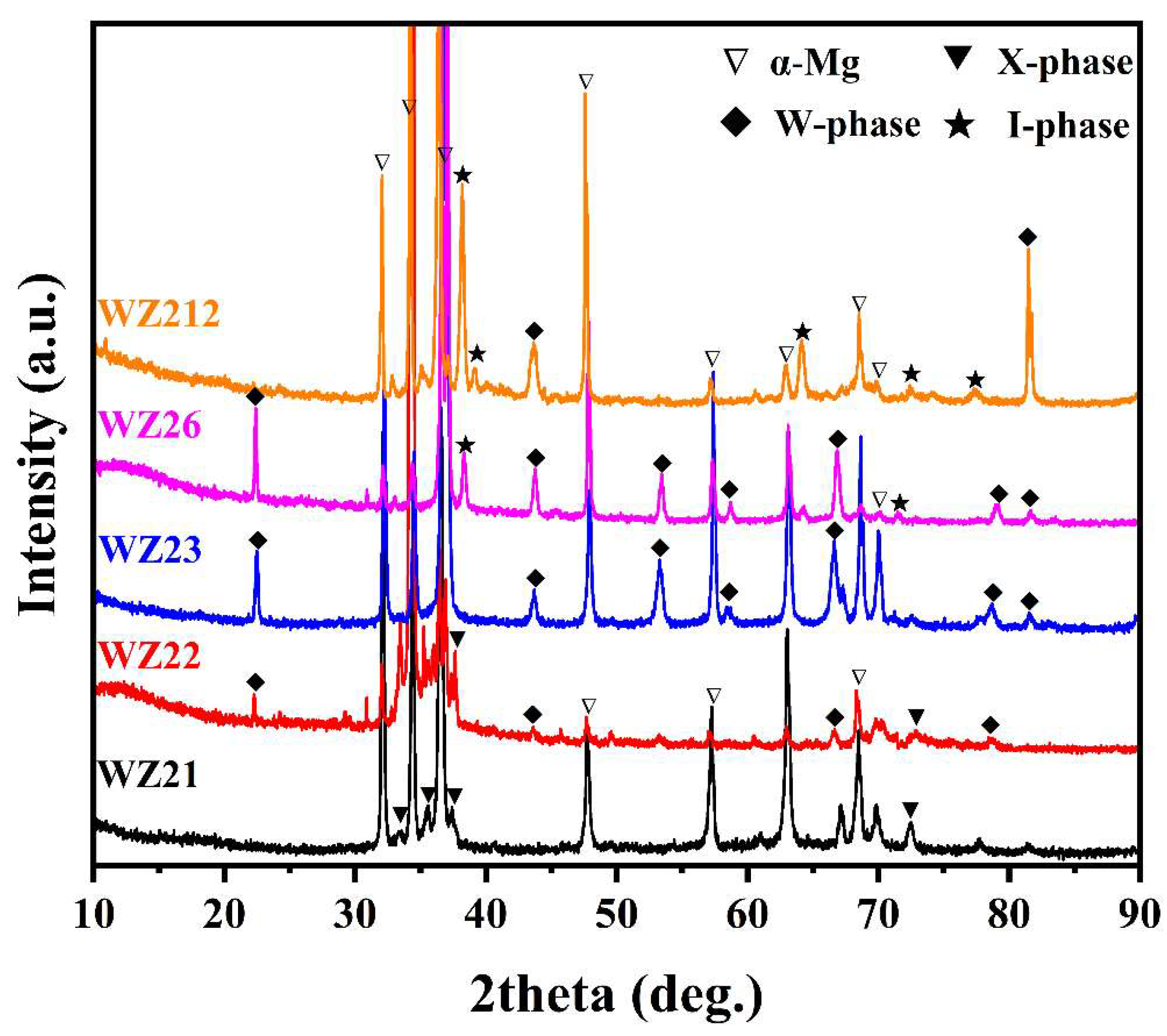
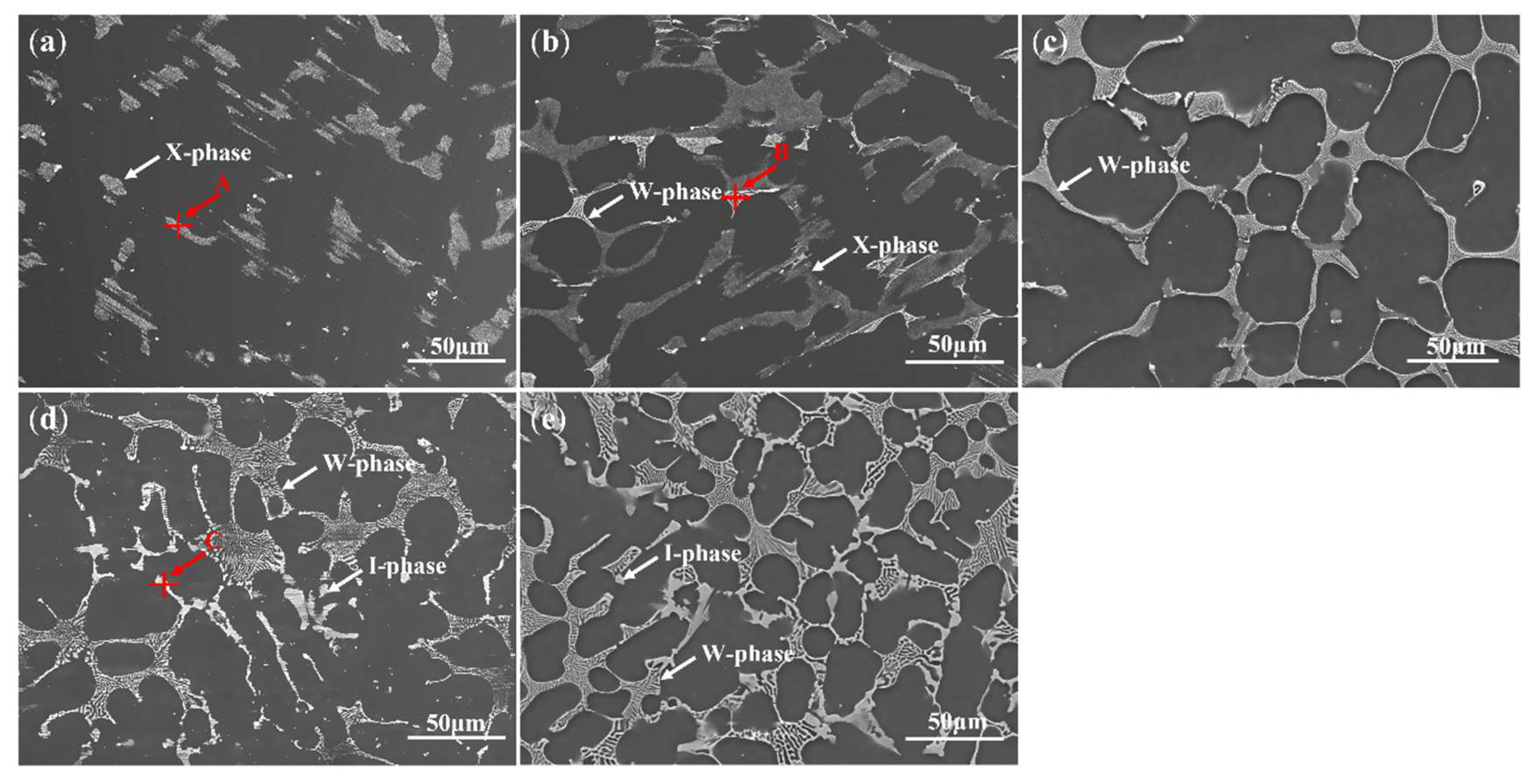
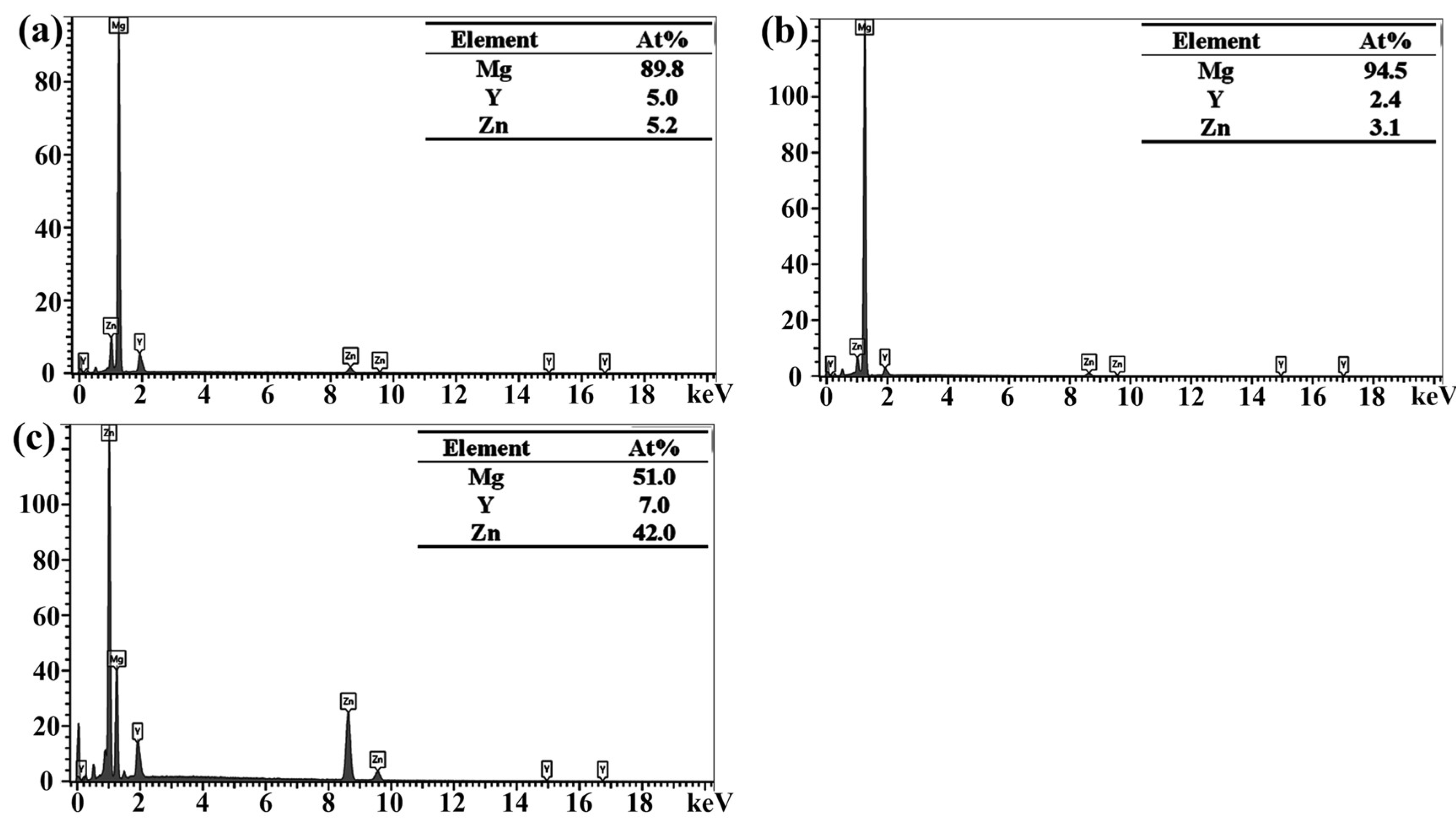
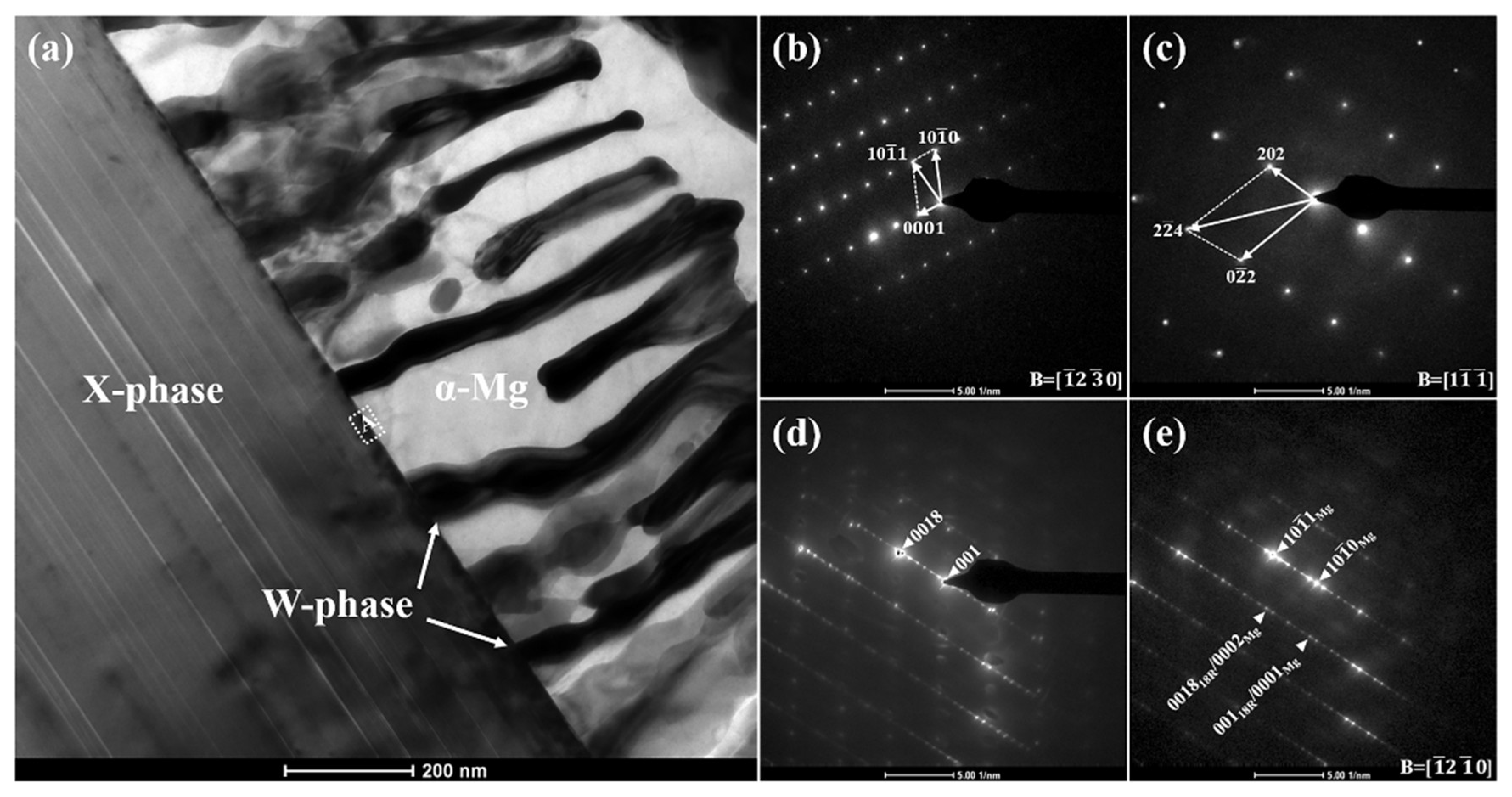

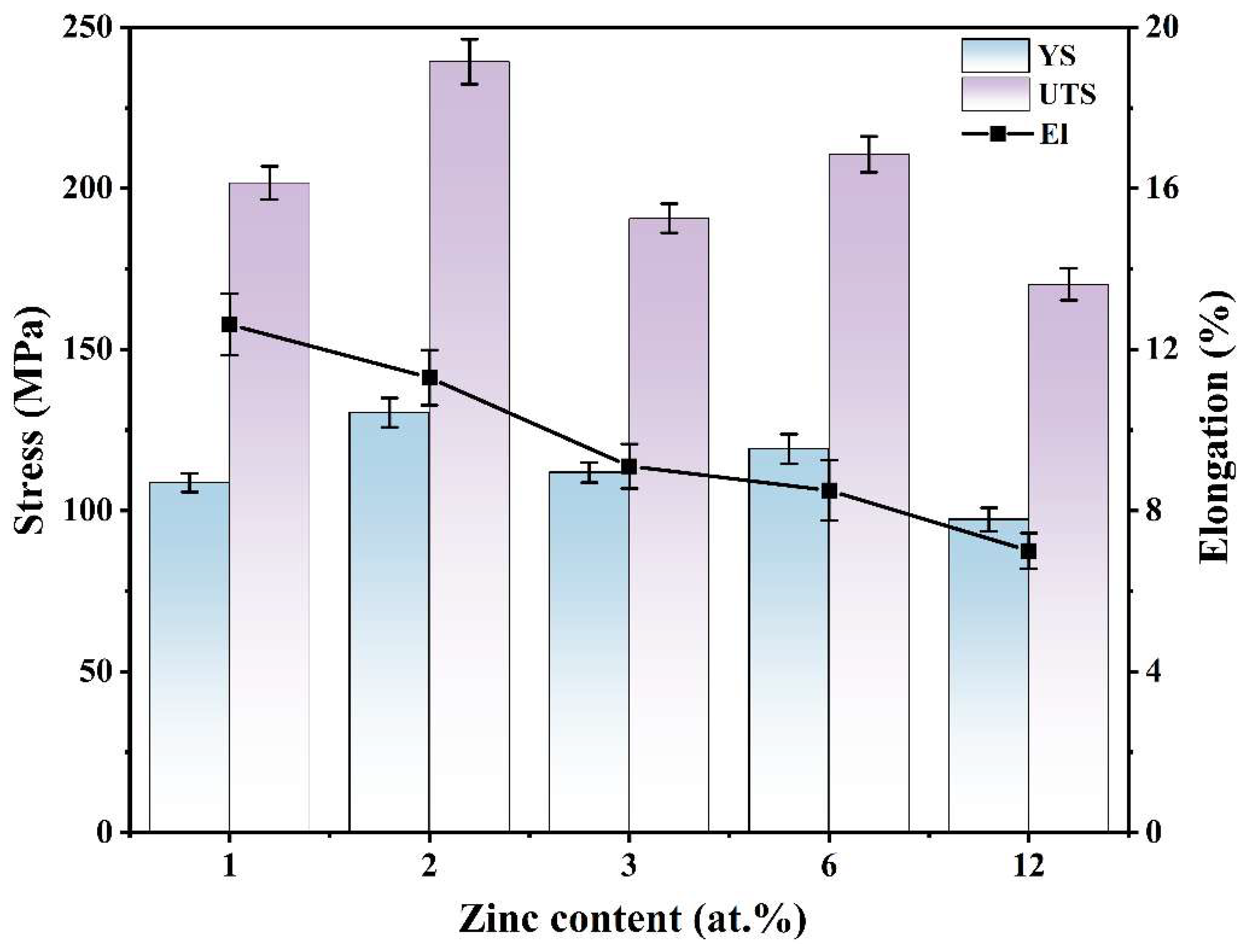

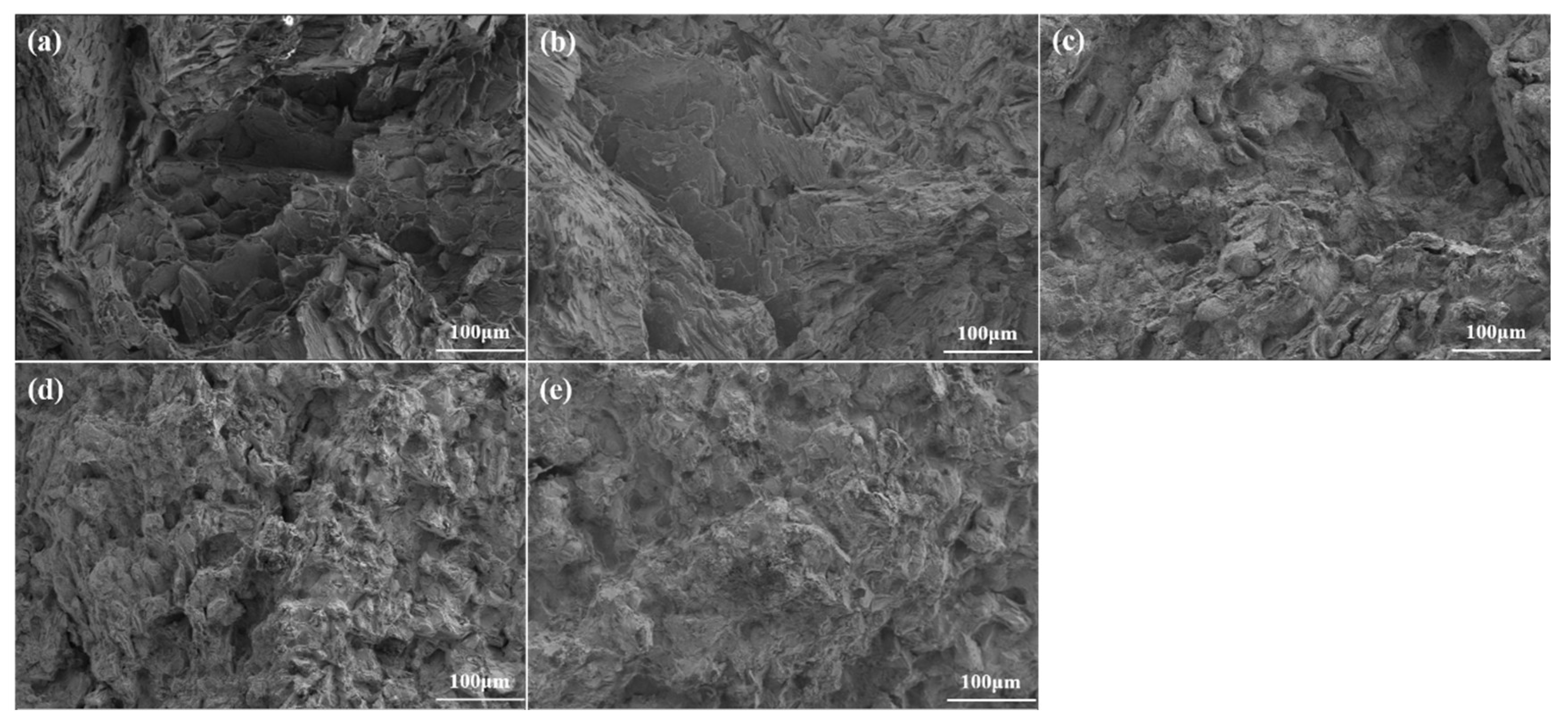
| Alloy | Nominal Composition | Actual Composition (at.%) | ||
|---|---|---|---|---|
| Y | Zn | Mg | ||
| WZ21 | Mg–2Y–1Zn | 1.95 | 0.95 | Bal. |
| WZ22 | Mg–2Y–2Zn | 1.99 | 2.03 | Bal. |
| WZ23 | Mg–2Y–3Zn | 1.92 | 2.98 | Bal. |
| WZ26 | Mg–2Y–6Zn | 1.98 | 6.11 | Bal. |
| WZ212 | Mg–2Y–12Zn | 1.94 | 11.83 | Bal. |
| Alloy | Transformation |
|---|---|
| WZ21 | L→α-Mg + L, L→α-Mg + X + Mg24Y5 |
| WZ22 | L→α-Mg + L, L→α-Mg + X + Mg24Y5 + W |
| WZ23 | L→α-Mg + W |
| WZ26 | L→α-Mg + W, L + W→α-Mg + I |
| WZ212 | L→α-Mg + W, L + W→α-Mg + I |
Disclaimer/Publisher’s Note: The statements, opinions and data contained in all publications are solely those of the individual author(s) and contributor(s) and not of MDPI and/or the editor(s). MDPI and/or the editor(s) disclaim responsibility for any injury to people or property resulting from any ideas, methods, instructions or products referred to in the content. |
© 2025 by the authors. Licensee MDPI, Basel, Switzerland. This article is an open access article distributed under the terms and conditions of the Creative Commons Attribution (CC BY) license (https://creativecommons.org/licenses/by/4.0/).
Share and Cite
Xu, L.; Xie, H.; Chen, K.; Feng, R.; Zheng, D.; Shou, H. Unveiling the Microstructure Evolution and Mechanical Strengthening Mechanisms in Mg–2Y–xZn Alloys. Materials 2025, 18, 3303. https://doi.org/10.3390/ma18143303
Xu L, Xie H, Chen K, Feng R, Zheng D, Shou H. Unveiling the Microstructure Evolution and Mechanical Strengthening Mechanisms in Mg–2Y–xZn Alloys. Materials. 2025; 18(14):3303. https://doi.org/10.3390/ma18143303
Chicago/Turabian StyleXu, Luyan, Huanjian Xie, Kuan Chen, Ruizhi Feng, Donghui Zheng, and Haoge Shou. 2025. "Unveiling the Microstructure Evolution and Mechanical Strengthening Mechanisms in Mg–2Y–xZn Alloys" Materials 18, no. 14: 3303. https://doi.org/10.3390/ma18143303
APA StyleXu, L., Xie, H., Chen, K., Feng, R., Zheng, D., & Shou, H. (2025). Unveiling the Microstructure Evolution and Mechanical Strengthening Mechanisms in Mg–2Y–xZn Alloys. Materials, 18(14), 3303. https://doi.org/10.3390/ma18143303






